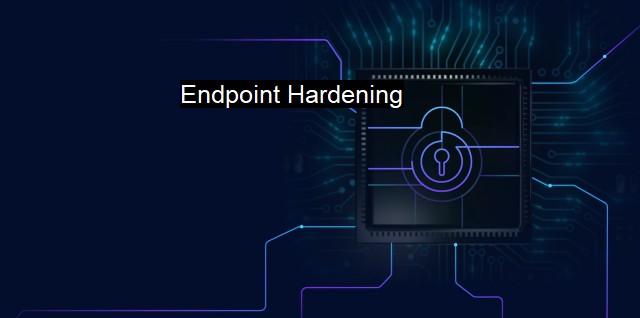What is Endpoint Hardening?
Endpoint Hardening: Strengthening Your Cybersecurity Defenses to Protect Against Attacks on Endpoint Devices
"Endpoint Hardening" is a fundamental concept predominantly related to the protection of computer networks from potential damage and exploitation by malicious software or unauthorized intruders. As we continue to integrate technology into our systems of operation—whether personal or professional—we often come across terms like "endpoint," "antivirus," and "cybersecurity." Each of these concepts plays an integral role in forming a robust digital environment that safeguards our data from potential threats. Undeniably, as the digital world evolves, the attention on cybersecurity has gradually shifted from safeguarding central systems to reinforcing the individual assets interacted within the network, commonly referred to as endpoints.In broad terms, an "endpoint" in a computer network is typically a remote computing device that communicates back and forth with the network it is connected to. These devices can vary from personal computers, laptops, smartphones to more complex setups like servers and cloud infrastructure. The function and influence of these endpoints largely depend on the kind of network infrastructure and application environments that are being used. The action of enhancing the security face of these endpoints is known as 'Endpoint Hardening'.
Generally speaking, Endpoint Hardening is the array of processes or methodologies put in place to fortify endpoint devices from security breaches. It's like providing an orchestrated boost in the level of security to endpoints to minimize the potential damage that could be inflicted upon them. Endpoint Hardening involves tailoring security measures to fit the unique vulnerabilities and configurations of endpoints, thereby reducing the exploitable security flaws.
In the cybersecurity ecosystem, Endpoint Hardening is closely tied to virus and malware protection. Antivirus software is a crucial component of this portfolio. It helps to ensure endpoints are impervious to trojans, viruses, worms, ransomware, spyware, adware, and other malicious software types. An antivirus strengthens endpoint integrity by consistently scanning for, identifying, and neutralizing these malicious pieces of code before they can pose any substantial risk.
Endpoint Hardening also involves managing the kind of applications that can run on these endpoints, limiting unauthorized software installation, restricting user access permissions, and more. It all falls under maintaining the endpoint hygiene – a mechanism to thwart potential malware attacks and ensure ongoing system integrity.
Software developers also apply Endpoint Hardening principles to programming practices, such as disabling unnecessary features, functions, reducing code vulnerabilities, or minimizing the scope of administrative permissions given to other software and users.
Another part of Endpoint Hardening focuses on identifying system vulnerabilities and rectifying any discovered loopholes. Regular patches, software updates, and upgrades are imperative to this process since developers often reinforce their software with security fixes based on newly identified vulnerabilities.
Organization-wide administrative controls such as access authentication protocols, user-level permission settings, regular software updates, network monitoring and controlling, firewall setups, and intrusion detection/prevention systems are all employed as preventative actions to guarantee comprehensive Endpoint Hardening.
Given today’s surging digitization, Endpoint Hardening in cybersecurity poses a significant shield against the ever-growing array of cybersecurity attacks. the combination of processes, methods, and tools is as effective as the competency and awareness of the users involved. Organizations must empower their users with cybersecurity education and practices to understand the interconnected responsibility they share in preserving their technological environment. All said and done, Endpoint Hardening is an ongoing journey, and with innovative threats emerging daily, the processes must adapt and evolve to remain effective.

Endpoint Hardening FAQs
What is endpoint hardening?
Endpoint hardening refers to the process of securing endpoints such as laptops, desktops, mobile devices, servers, and other networked devices against cybersecurity threats. It involves implementing security measures and controls to reduce the risk of cyber attacks and data breaches.Why is endpoint hardening important?
Endpoint hardening is important because endpoints are often the weakest links in the cybersecurity chain. Endpoints can be easily compromised by cybercriminals, giving them access to sensitive data and critical systems. Endpoint hardening helps to prevent these attacks and protect your organization’s information assets.What are some best practices for endpoint hardening?
There are several best practices for endpoint hardening, including installing antivirus software, keeping all software and operating systems up to date, implementing strong password policies, limiting user access privileges, using firewalls, encrypting data, and conducting regular security audits. These measures can help to reduce the risk of cyber attacks and protect your organization’s data.How can endpoint hardening be implemented in an organization?
Endpoint hardening can be implemented in an organization by conducting a risk assessment, identifying vulnerable endpoints, developing a security strategy, selecting appropriate security technologies, deploying and configuring security solutions, monitoring for security breaches, and conducting regular security training for employees. It is important to create a culture of security awareness and to continually evaluate and improve your endpoint security posture.| | A | | | B | | | C | | | D | | | E | | | F | | | G | | | H | | | I | | | J | | | K | | | L | | | M | |
| | N | | | O | | | P | | | Q | | | R | | | S | | | T | | | U | | | V | | | W | | | X | | | Y | | | Z | |
| | 1 | | | 2 | | | 3 | | | 4 | | | 7 | | | 8 | | |||||||